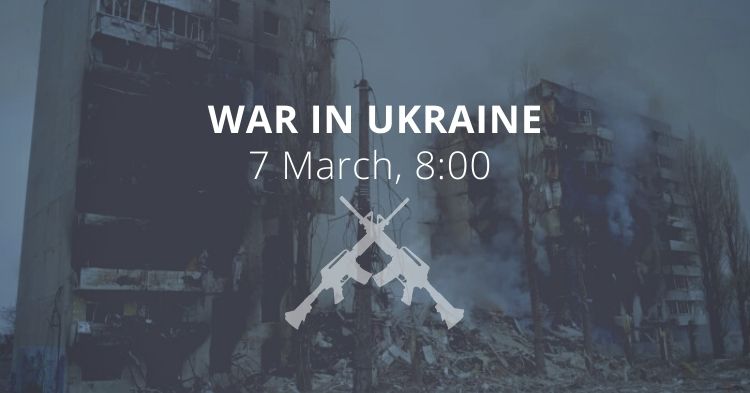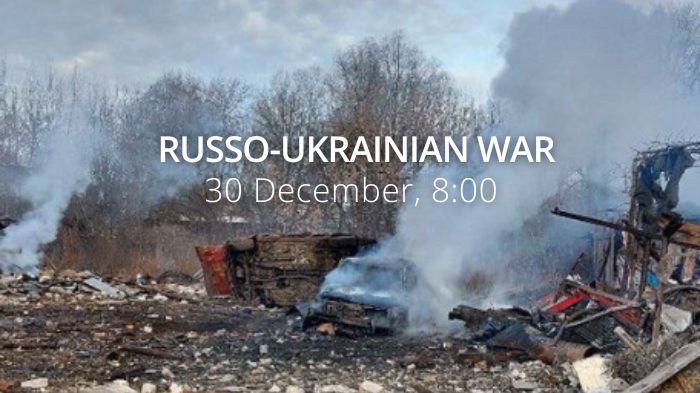Russian forces conducted a few limited and highly localized ground attacks. Russian troops have used up to 55-60% of Russia’s pre-war reserve of high-precision missiles. Russian forces move military equipment and explosives to the engine room at Zaporizhzhia Nuclear Power Plant violating fire safety guidelines. Zelenskyy says the latest EU sanctions against Russia are not enough.
Daily overview — Summary report, July 22
A map of the approximate situation on the ground in Ukraine as of 00:00 UTC 22/07/22.
There have been no notable changes to control since the last update. pic.twitter.com/jprbDZnayM
— War Mapper (@War_Mapper) July 22, 2022
According to military expert Stanislav Haider, as of July 22,
Donetsk and Luhansk oblasts. In the far east of Donetsk Oblast, Ukrainian troops repelled weak Russian attacks on the Vuhlehirsk power plant and Vershyna, and also repelled a Russian assault on Ivano-Daryivka from the direction of the Lysychansk Oil Refinery. Novoluhanske, Siversk, and Bohorodychne remain under the control of the Armed Forces of Ukraine. “Interesting events are developing near Mariinka,” Haider says. Previously, there were reports on Ukrainian limited counterattacks in the area.
Kharkiv direction. In the north of Kharkiv Oblast, Ukrainian forces repulsed a Russian assault on Pytomnyk from Velyki Prohody. There is a partial advance of the Ukrainian Armed Forces in Chuhuiv district.
Kherson and Zaporizhzhia oblasts. There are several places where the Russians are surrounded in Kherson Oblast. One of them is Vysokopillia. On June 30, Ukrainian defenders liberated Potiomkyne, and before July 5 they controlled Olhyne.
“The Russians didn’t pull back their garrison from Vysokopillia and were unable to reinforce it. Now they are doomed,” Haider says.
Ukrainian troops repelled the assaults of the Russian forces from Davydiv Brid to Bilohirka and from Mala Seidemynukha to Andriivka. The Russians shelled Kyselivka, which shows that they no longer control this settlement.
The Ukrainian artillery destroyed a Russian ammunition warehouse in Beryslav district, a Russian base in Skadovsk, an ammo depot near Chornobayivka (all: Kherson Oblast), and one more ammunition dump in Yasynuvata, Donetsk Oblast.
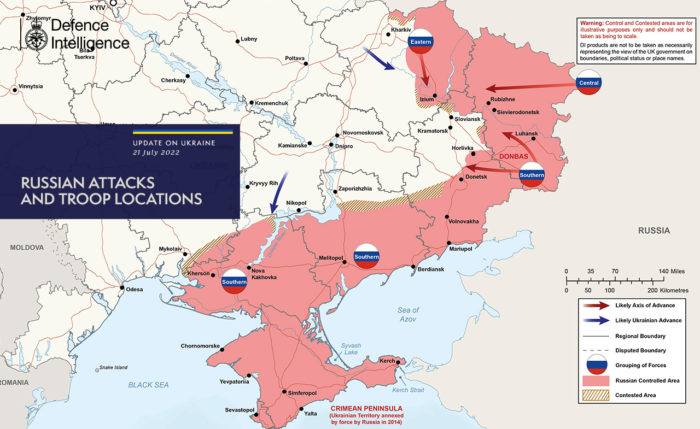
The General Staff’s operational update regarding the Russian invasion as of 06.00 am, July 22, 2022 is in the dropdown menu below.
https://twitter.com/EuromaidanPress/status/1550137813051506690
According to information from the General Staff as of 06.00 22.07.2022, supplemented by its [18:00 assessment].
“The situation has not undergone any significant changes in the Volyn and Polissya directions. The deadlines for checking the combat readiness of the armed forces of the Republic of Belarus have been extended until July 31 of this year. [During July of this year, on the territory of the Republic of Belarus, a campaign of agitation of citizens of this country to sign contracts with Russian private military companies is ongoing. The military commissariats of the armed forces of the Republic of Belarus take an active part in these events.]
In the Siversky direction, in order to demonstrate their presence, Russian forces are shelling the positions of our units and civilian infrastructure in the areas of the settlements of Kamianska Sloboda and Mykolaivka of the Chernihiv oblast and Volfyne and Pavlivka of the Sumy Oblast. Conducted aerial reconnaissance of tactical-level UAVs.
[In the Slobozhansky direction:]
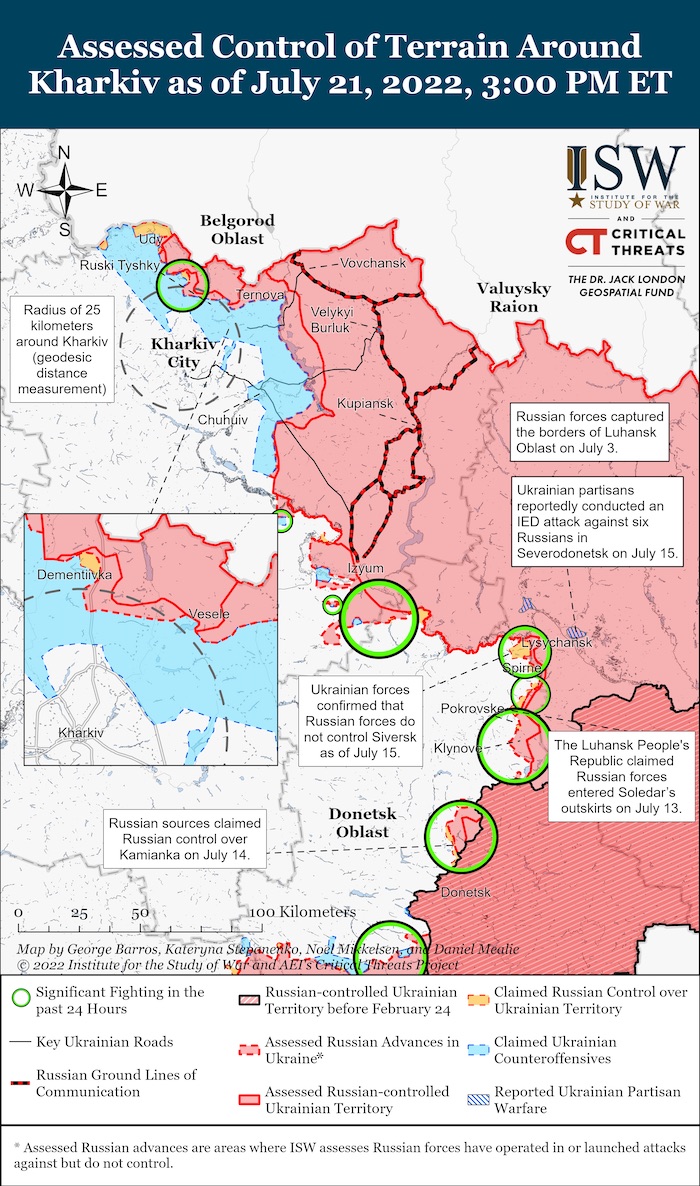
- In the Kharkiv direction, Russian forces shelled the areas of Mospanove, Ruski Tyshky, Dementiivka, Zolochiv, Stara Hnylytsia, Ridne, Rtishchivka, Pushkarne, Velyka Babka, Petrivka, Slatyne and Lebyazhe settlements with artillery. [Yesterday, Russian forces launched airstrikes near Verkhniy Saltiv and Rtyshivka. It carried out artillery shelling in the districts of Kharkiv, Pytomnik, Ruska Lozova, Rubizhne, Cherkaski Tyshky, Prudyanka, Chuhuyev, Udy, Korobochkyne, Zalyman and Malynivka.]
- [Yesterday, they unsuccessfully tried to advance in the direction of Velyki Prohody – Pytomnyk with assault actions. Russian forces also carried out aerial reconnaissance with an unmanned aerial vehicle near Slatyne, Rubizhne, Zamulivka and Dementiyvka.]
In the Sloviansk direction, the occupiers fired artillery near Dibrovne, Chepil, Adamivka, Karnaukhivka, Mykilsky, Kurulka, Khreshtyshe and Mazanivka. [Yesterday, Russian forces launched artillery fire in the areas of Dolyna, Bohorodychne, Husarivka, Velyka Komyshuvaha, Nortsivka, and Virnopillya settlements. Conducted aerial reconnaissance near Dmytrivka and Virnopilla.
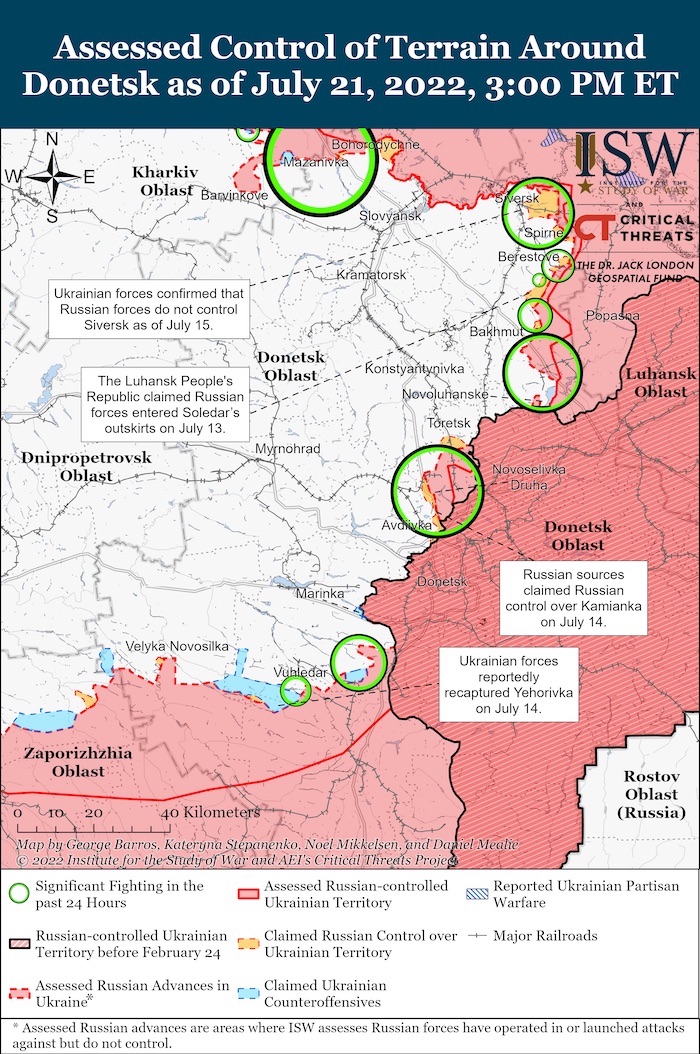
In the Donetsk direction, Russian forces’ main efforts are concentrated in the Kramatorsk and Bakhmut directions. Carries out systematic shelling of the positions of our troops along the contact line to prevent the transfer of reserves to other directions. Attempts are being made to replenish stocks of ammunition and fuel and oil.
- In the Kramatorsk direction, Russian forces carried out fire from tanks and MLRS in the vicinity of Donetsk, Serebryanka, Verkhnyokamyanske, Spirne and Ivano-Daryivka. It launched an airstrike near the latter. Conducts assault operations in the direction of Verkhnokamyanka – Verkhnokamyanske, hostilities continue. [Yesterday, Russian forces carried out airstrikes in the areas of Serebryanka and Spirne. Artillery shelling was recorded near Siversk, Hryhorivka and Ivano-Daryivka. Enemy UAVs operational-tactical level operated near Rozdolivka and Hryhorivka.]
- [Yesterday, Ukrainian soldiers repulsed the offensive of the occupiers in the direction of the Lysichansk refinery – Ivano-Daryivka. Russian forces suffered losses and retreated.]
- In the Bakhmut direction, Russian forces fired at our troops from available firepower in the areas of the settlements of Berestove, Bakhmut, Kostyantynivka, Bilohorivka, Pokrovske, Kodema, Vesela Dolyna, New York, Yakovlivka, Vasyukivka, Klishchiivka and the territory of the Vuhlehirska TPP. Made an airstrike near Straipivka. [Yesterday, Russian forces carried out airstrikes in the areas of Vershina, Bilohorivka, Kostyantynivka and Berestove settlements. Artillery shelling was recorded in the vicinity of Berestove, Vesele, Vyimka, Vershyna, Novoluhanske, Bakhmut, Zaytseve, Soledar, Rozdolivka, and Kurdyumivka.]
- Assault actions in the directions Dolomitne – Novoluhanske and Straipivka – Soledar ended with losses for Russian forces. Our soldiers drove the disorganized units of the invaders back. Russian forces continue to attempt an assault in the direction of the Vuhlehirska TPP and near Pokrovske, hostilities continue. [The weak assaults of the occupiers on the directions Klynove – Vershyna, Myronivka – Vuhlehirska TPP yesterday, failed ]
- On the Avdiivka, Novopavlivka, and Zaporizhzhia directions, Russian forces fired artillery in the areas of Pisky, Avdiivka, Novomykhailivka, Prechistivka, Zaliznychne, Pavlivka, Vremivka, Novoandriivka, Shevchenko, Ternuvate, Volodymyrivka, Novoyakovlivka, Mali Shcherbaki, Kamianske, and Poltavka. An airstrike was recorded near Prechistivka. [Yesterday, to restrain the actions of our troops, Russian forces carried out airstrikes near Krasnohorivka, Kamianka, Solodke, and Novoandriivka. It carried out artillery shelling in the areas of the settlements of Avdiivka, Krasnohorivka, Pisky, Zolota Nyva, Mykilske, Zaliznychne, Stepnohirsk, Novoselivka Druga, Vugledar, Hulyaipilske, Novopil, Bilohirya. To adjust the artillery fire, operational-tactical level unmanned aerial vehicles were used near Shcherbaky, Malaya Tokmachka and Bilohirya.]
In the Pivdenny Buh directions, Russian forces are defending the previously occupied positions, are concentrating their efforts on preventing the offensive of the Defense Forces, and have introduced reserve units.
- Artillery shelling was noted in the areas of the settlements of Ivanivka, Tokarevo, Trudolyubivka, Partyzanske, Kobzartsi, Posad-Pokrovske, Andriivka, Stepova Dolyna, Tavriyske, Olenivka, Shevchenkove, Prybuzke, Lymany, Kiselivka, Novomykolaivka, Velyke Artakove, Mykolaiv and Tetyanivka. [Yesterday, artillery shelling was recorded in the areas of the settlements of Olgyne, Potemkine, Knyazivka, Shyroke, Ternivka, Luch, Kotlyareve, Pervomaiske, Nova Zorya, Dobre and Bila Krynytsya. The occupiers unsuccessfully tried to launch a counterattack in the direction of Sukhy Stavok – Andriivka.]
- All attempts of enemy assaults in the direction of Mala Semeydynukha – Andriivka and Davydiv Brid – Bilohirka were immediately suppressed by our soldiers. The occupiers retreated.
[In the Black Sea and the Sea of Azov, the Black Sea Fleet focuses its main efforts on blocking civilian shipping in the northwestern part of the Black Sea.] It has three warships carrying Kalibr cruise missiles on station in the Black Sea.
Ukrainian aviation and missile and artillery units continue to successfully fire at concentrations of manpower, military equipment of the Russian occupiers, and warehouses with ammunition. As a result of the losses, Russian forces’ personnel in many areas refused to go into battle and resorted to sabotage.
[Personal documents are confiscated from the forcibly mobilized, who are taken to replenish their losses from the temporarily occupied territories of Donetsk and Luhansk oblasts. This shows the complete lawlessness of this contingent and, allegedly, should stop desertion. Also, it will not allow identification of the mentioned persons in case of death, which opens the way for various financial frauds in favour of the command staff of the armed forces of the Russian federation.]”
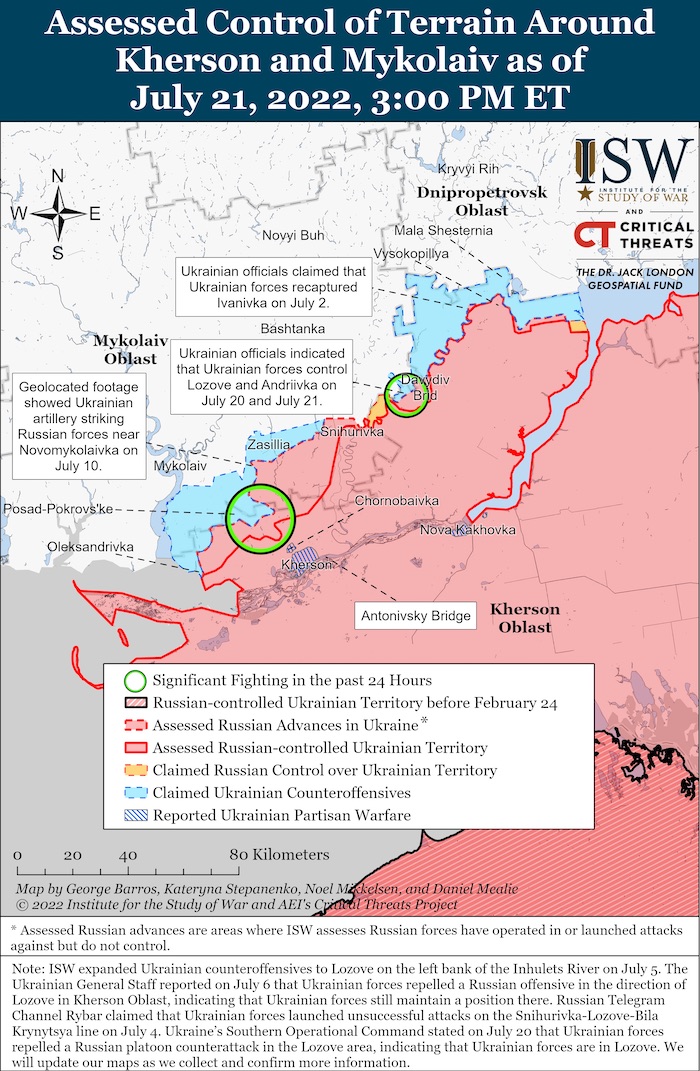
Military Updates
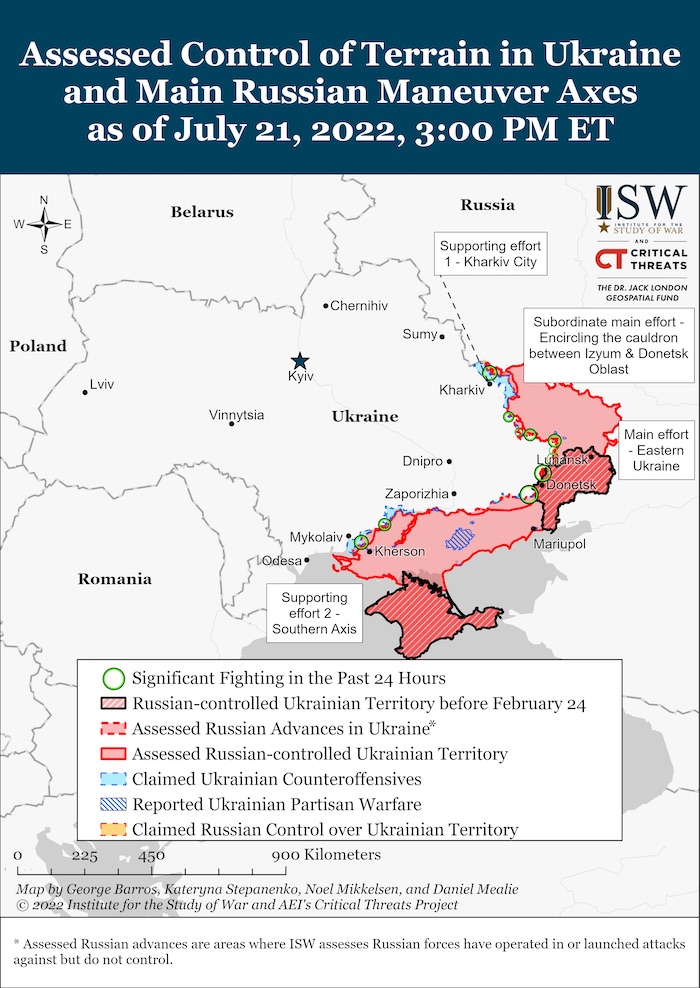
Russia has used over 50% of its “high-precision” weapons — intelligence, Ukrainska Pravda reports. Military intelligence has assessed the Russian use of high-precision weapons. “Those Iskander, Kalibr, air-launched cruise missiles, Kh-101s, Kh-555s — according to our calculations, 55-60% of the pre-war reserves have been used to date.
Most of the ballistic missiles used were for the Iskander system, which is why we haven’t seen the use of this missile for a long time. At the same time, Skibitskyi emphasised that Russia has very large reserves of old Soviet weapons. These include cruise missiles (for example, Kh-22s, which have been used twice from the territory of Belarus, and others), a full set of Smerch, Uragan and Grad rockets, and various kinds of aerial bombs. Everything that remained from the USSR (and the reserves were very large), and it is very difficult to calculate how much is left, Skibitskyi added.”
The US general hinted at the transfer of Western fighter jets to Ukraine
"There's U.S. [fighter jets], there's Gripen out of Sweden, there's the Eurofighter or the Rafale…that could go to Ukraine, said Air Force Chief of Staff.https://t.co/JxKrxPhFZJ
Patrick Semansky/AP Photo pic.twitter.com/Ub1kPPIOEH— Euromaidan Press (@EuromaidanPress) July 21, 2022
South: the aviation of the Armed Forces of Ukraine struck enemy strongholds and concentrations, Ukrainska Pravda reports, citing Operational Command South. “[Yesterday,] Ukrainian aviators made 8 strikes against enemy positions and supplies. Bombers and attack aircraft made 5 strikes, and helicopter pairs – 3. Damage was inflicted on five strongholds and two ammunition depots in the Skadovsky and Berislavsky districts of the Kherson region, as well as on the site of the concentration of enemy personnel in the Mykolaiv region. In total, the missile and artillery units of the Armed Forces of Ukraine completed more than 230 fire missions.”
According to British Defence Intelligence, (last 48 hours):
- In the Donbas, Ukrainian forces continue to repel Russian attempts to assault the Vuhlehirsk power plant. Russian artillery remains focused on areas around the cities of Kramatorsk and Siversk.
- On 21 July 2022, Vitaly Kim, governor of Ukraine’s Mykolaiv region, said that Russian forces had used seven air defence missiles to strike infrastructure, energy facilities and storage areas.
- Russia has increased its use of air defence missiles in a secondary ground attack mode because of critical shortages of dedicated ground-attack missiles. Russia has almost certainly deployed S-300 and S-400 strategic air defence systems, designed to shoot down aircraft and missiles at long ranges, near Ukraine from the start of the invasion.
- These weapons have relatively small warheads, designed to destroy aircraft. They could pose a significant threat against troops in the open and light buildings but are unlikely to penetrate hardened structures. There is a high chance of these weapons missing their intended targets and causing civilian casualties because the missiles are not optimised for this role, and their crews will have little training for such missions.
- Russian and separatist forces continue to attempt small-scale assaults along the Donbas front line. Russian forces are likely closing in on Ukraine’s second biggest power plant at Vuhlehirska, 50km northeast of Donetsk.
- Russia is prioritising the capture of critical national infrastructure, such as power plants. However, it is probably also attempting to break through at Vuhlehirska, as part of its efforts to regain momentum on the southern pincer of its advance towards the key cities of Kramatorsk and Sloviansk.
Losses of the Russian army
As of Friday 22 July, the approximate losses of weapons and military equipment of the Russian Armed Forces from the beginning of the war to the present day:
- Personnel – more than 39000 (+150),
- Tanks – 1704 (+0),
- Armored combat vehicles – 3920 (+8),
- Artillery systems – 863 (+4),
- Multiple rocket launchers –MLRS – 251 (+0),
- Air defense means – 113 (+0),
- Aircraft – 221 (+0),
- Helicopters – 188 (+0),
- Automotive technology and fuel tanks – 2803 (+22),
- Vessels/boats – 15 (+0),
- UAV operational and tactical level – 713 (+3),
- Special equipment – 72 (+0),
- Mobile SRBM system – 4 (+0),
- Cruise missiles – 167 (+0)
Russian enemy suffered the greatest losses (of the last day) in the Kryvyi Rih and Bakhmut directions.
⚰️russia's combat losses in Ukraine as of July 22
▪ 39000 killed soldiers (+150)
▪ 3920 APV (+8)
▪ 1704 tanks
▪ 863 artillery systems (+4)
▪ 221 aircraft and 188 helicopters
▪ 15 boats and cutters #StopRussia #StandWithUkraine pic.twitter.com/Fh0nxBhWRC— VoxUkraine (@voxukraine) July 22, 2022
Humanitarian
Collaborate with the #Russia invaders or lose all rights to your homes in occupied #Mariupol #Ukraine #StandWithUkraine #RussiaWarCrimes #StopRussia #filtrationhttps://t.co/z6oZsI5lDp pic.twitter.com/1WSpPEyMiw
— Halya Coynash (@halyapuff) July 21, 2022
Millions of refugees from Ukraine have crossed borders into neighbouring countries, and many more have been forced to move inside the country. The escalation of conflict in Ukraine has caused civilian casualties and destruction of civilian infrastructure, forcing people to flee their homes seeking safety, protection and assistance the UNHCR reports. As of 19 July:
Individual refugees from Ukraine recorded across Europe: 5,988,696
- Belarus, Hungary, Republic of Moldova, Poland, Romania, Russian Federation, Slovakia 3,274,532
- Other European countries 2,714,164
Refugees from Ukraine registered for Temporary Protection or similar national protection schemes in Europe: 3,709,329
- Hungary, Poland, Romania, Slovakia 1,392,951
- Other European countries 2,316,378
Border crossings from Ukraine (since 24 February 2022): 9,567,033
Border crossings to Ukraine (since 28 February 2022): 3,793,403
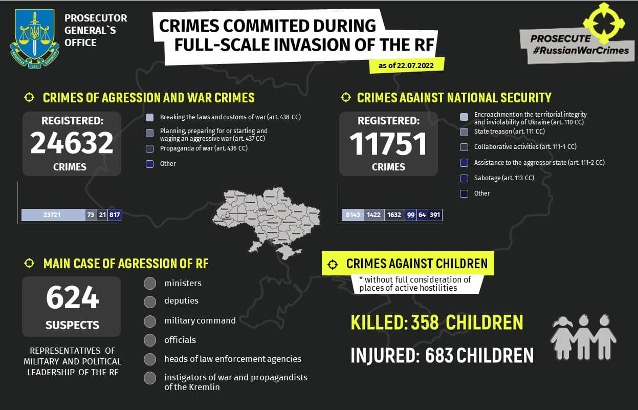
OHCHR recorded 11,776 civilian casualties in Ukraine as of July 17. 5,024 were killed (including 34 children) and 6,752 injured (including 533 children).
Ukrainian doctors successfully removed a shrapnel fragment from a beating heart of a soldier pic.twitter.com/jjrmwAUwHM
— Euromaidan Press (@EuromaidanPress) July 21, 2022
️️Environmental
Russian forces move equipment and explosives to the engine room at Zaporizhzhia Nuclear Power Plant, Ukrinform reports, citing Ukraine’s National Nuclear Energy Generating Company Energoatom. “Russian invaders have moved military equipment, explosives, and weapons to the engine room of power unit No. 1 at the Zaporizhzhia Nuclear Power Plant.
The entire arsenal of heavy equipment with all ammunition is currently located very close to the equipment that ensures the operation of the turbo generator. In particular, in the immediate vicinity of the main oil tank, which contains flammable oil that cools the steam turbine. There is also explosive hydrogen, which is used to cool the generator,” the post says.
It also added that the military equipment of the invaders made it impossible for fire engines and other vehicles to access the control room of power unit No. 1. Therefore, the risk of fire increases many times, and its extinguishing becomes extremely problematic. If a fire breaks out, for example, due to the accidental detonation of ammunition, its scale may be equal to the fire that occurred during the accident at the Chornobyl Nuclear Power Plant, Energoatom said.
The post notes that the occupiers continue to violate all norms and requirements regarding fire, nuclear and radiation safety at nuclear power plants, keeping heavy military equipment, ammunition, weapons and explosives in the engine room of the power unit of the largest nuclear power plant in Europe.
Energoatom once again insists on the need to liberate the Zaporizhzhia NPP as soon as possible and once again appeals to the international community with the request to take measures for this, because only Ukraine will be able to guarantee the smooth and safe operation of the Zaporizhzhia NPP.”
https://twitter.com/EuromaidanPress/status/1550190164328288259
The Energy War Escalates, The New York Times reports. “Europe plans to force gas rationing to deal with Russia’s likely supply cutoff. Europeans already sizzling under a heat wave and anxious about the war got some more bad news today: They may be forced to ration the use of natural gas to save the region from a major energy crisis if Russia cuts off supplies. Under a plan to be discussed by the European Union, countries would start rationing immediately and would cut their use of natural gas by 15 percent by springtime.
“Russia is blackmailing us. Russia is using energy as a weapon,” Ursula von der Leyen, the head of the European Commission, the bloc’s executive arm, said as she introduced the plan. If the E.U.’s 27 member countries agree to the measure, it will put Europe’s economy on a war footing, my colleague Matina Stevis-Gridneff writes. E.U. energy ministers are set to meet next week in Brussels to debate the plan.
The E.U. imported 155 billion cubic meters of gas from Russia last year, some 40 percent of its total gas imports. Gas makes up a quarter of its energy mix and is overwhelmingly what Europeans use to heat their homes. Since the start of the war, Russia has cut supplies to the bloc. There are fears that a key pipeline, currently down for regular maintenance, may not come back on at full steam.
President Vladimir Putin said yesterday that gas flows via the Nord Stream 1 pipeline would resume, but warned that supplies could be severely curtailed. Gas storage facilities are not sufficiently stocked to deal with the disruptions and experts say that cutting demand for gas is the only way to survive relatively unscathed this winter. The E.U. is also trying to line up new suppliers.
The plan will test European solidarity: While Germany is heavily reliant on gas, southern European nations like Italy and Spain barely use it, and France relies mostly on nuclear energy for electricity needs. Public opinion is split on whether continuing to support Ukraine is worth the economic pain. Support for Kyiv tends to be higher in countries that were once part of Moscow’s sphere of influence under the Warsaw Pact.
But even in Germany, a poll last week found that only 22 percent of those surveyed wanted their government to curb support for Ukraine to bring down energy prices; 70 percent of respondents said that they wanted the German government to continue strongly backing Ukraine despite the economic fallout.”
Legal
On the Status of Russian War Crime Investigations, Ukraine World reports.
- On the current status of the investigation into Russian war crimes in Ukraine
- 17,000 war crime cases have been initiated by Ukrainian law enforcement agencies since the beginning of the Russian invasion on February 24, according to the Prosecutor General of Ukraine;
- The Ukrainian criminal justice system is overloaded with a large number of war crime cases. In Kharkiv Oblast, there are 300 war crimes cases per one investigator;
- Because of a large number of war crime cases, Ukrainian investigators will prioritize the most resonant war crimes, such as: the Russian missile attack on the Kramatorsk railway station on April 8, which resulted in 61 civilians killed and 121 wounded; the Russian airstrike on Mariupol drama theater on March 16, which allegedly resulted in 600 civilians killed; mass murders of civilians by Russian soldiers in the occupied territories. In Kyiv Oblast alone, 1,346 civilians have been murdered, according to the current estimates; the Russian missile attack on the Kremenchuk shopping center on June 27, which resulted in 22 civilians killed and 64 wounded; the Russian airstrike on Mariupol maternity hospital on March 9, which resulted in 3 civilians killed and 17 wounded; other Russian war crimes which resulted in the high death toll among civilians.
- It is impossible to investigate some war crime cases since a part of Ukrainian territory is still occupied by Russia.
- On the character of Russian war crimes in Ukraine
- Hundreds of Ukrainian civilians have been murdered by Russians under the common pattern — shot in the head with hands tied behind their backs. The victims were civilian men aged 18 to 60 years. These crimes have an element of a crime of genocide;
- There are over 600 cases of enforced disappearance of Ukrainian civilians, mainly in Kharkiv, Kherson, and Zaporizhzhia Oblasts. The number of cases is rapidly increasing. If it reaches 1,000, these war crimes will be qualified as crimes against humanity;
- From 1,3 to 1,7 million Ukrainians from the occupied territories have been forcibly displaced to Russia. One-third of them are Mariupol residents;
- 50,000 Ukrainian civilians in the occupied territories have been forcibly mobilized to the Russian army;
- 70% of the total number of Russian war crimes are connected to the consequences of artillery shelling, missile and bomb attacks;
- Russians have used prohibited projectiles, such as cluster munitions and phosphoric bombs;
- There are over 12,350 cases of destruction of civilian objects, mostly by artillery shelling and airstrikes;
- Other war crimes committed by Russians are torture and inhuman treatment of Ukrainian POWs and civilians, taking civilians as hostages, attacking humanitarian corridors, convoys, and missions, rape, using civilians as a human shield, using insignia and uniforms of Ukrainian forces, etc.
358 children were killed, and 683 children injured, the Office of the Prosecutor General of Ukraine reports as of July 22. 2,188 educational establishments are damaged as a result of shelling and bombings, 221 of them are destroyed fully. 24,632 crimes of aggression and war crimes and 11,751 crimes against national security were registered.
Support
Ukraine's partners give new commitments concerning land, sea, and air – Defense Minister Reznikov
"These include weapons & ammo, training of our soldiers & more," he said after 4th Ramstein meeting. Ramstein group unites 50 countries from all continentshttps://t.co/V5OGDrMZQC pic.twitter.com/myvhYEUKoL
— Euromaidan Press (@EuromaidanPress) July 21, 2022
Three priorities for Ukraine were discussed during the latest Rammstein meeting, NV.Ua reports. “Ukraine’s Defense Minister Oleksii Reznikov outlined the results of the fourth meeting of the Ukraine Defense Contact Group. The fourth meeting of the Ukraine Defense Contact Group has taken place. This platform in support of Ukraine known as the Ramstein format was established thanks to US leadership and now unites 50 countries from all continents (except for Antarctica).
Unity is the source of our strength and a guarantee of our future victory over the Russian invaders. As agreed with colleagues, we hold the intrigue regarding a lion’s share of existing and upcoming aid packages. These include weapons and ammo, training of our soldiers, and more. At first, Russian forces will feel this aid on the battlefield. Positive signals from the meeting are new obligations of the partners concerning land, sea, and sky. […] The next aid package from the US to be announced this week includes inter alia four M142 HIMARS systems that are already affecting the course of the war.
I would like to note that the American partners, as well as colleagues from other countries, expressed their admiration for the skill of our soldiers, including the way they use artillery and HIMARS. […]
In my speech, I emphasized three priorities for Ukraine. Firstly, it is the strengthening of the mission-oriented approach. We ask the colleagues to concentrate their efforts on increasing the capabilities of the Ukrainian armed forces to carry out certain missions. One of them is unblocking our ports and ensuring safety in the western part of the Black Sea. Everyone saw the first results in the form of liberating Zmiinyi (Snake) Island. The work continues. New “gestures of goodwill” from the invaders are possible.
Secondly, it is time to systematize the maintenance and repair of foreign equipment supplied to us. It is a large-scale task, and we are already talking about hundreds of units. We need coordination of many countries in the legal, financial, and organizational spheres as well as at the level of production capacities.
Thirdly, we are increasing efforts to ensure transparency in registering and using international military aid. In particular, the implementation process of the NATO LOGFAS program will be accelerated.
I will also point out three things I have heard from colleagues. Firstly, a number of countries directly stated that there was no fatigue from the war in Ukraine and that no such thing would happen in the future. There is an understanding that the security of the whole of Europe is at stake, not just Ukraine.
The whole world sees how our defenders hold the front line over 2 500 km long. It is like the distance between Warsaw to Barcelona. The perception of Ukraine as a shield of Europe in the east is getting clearer. Generally, there is the common position of Ramstein members to support Ukraine until its victory.
Secondly, it was numerously emphasized that time is of the essence. I stressed that in my speech. However, this thesis already exists on the agenda of those supporting us. We are doing everything to put all this into practice.
Thirdly, a lot of partners are ready to train our soldiers. It is an opportunity to get high-quality reserves that will master western weaponry behind front lines. Also, this will set the stage for increasing the amount of support.”
Army barracks in Germany are ground zero for the flow of West’s weapons to Ukraine, Stars and Stripes reports. Dozens of troops from 26 nations occupy the computer-filled room, where the US and its partners are tasked with ensuring that everything from Stinger missiles and howitzers to drones and long range-artillery gets to secret rally locations.
After the handoffs, Ukrainian convoys, which are high-value targets for the Russians, make their way to the front. And so far, the Russians have been unable to stop them, US military officials said Wednesday. The reason is “a lack of air support superiority from the Russians,” said Rear Adm. R. Duke Heinz, EUCOM’s top logistician and head of a special task force coordinating efforts to get arms into Ukraine.
To date, more than 78,000 tons of weaponry have made their way to Ukraine via secret routes. The task force, known as the EUCOM Control Center Ukraine, has been at the centre of it all. Formed in March, the multinational cell operates 24 hours a day to stay on top of the latest calls for support coming from Ukraine.
For EUCOM and its partners, the effort to divvy up weapons bears an organizational resemblance to signing up for a wedding registry. It all begins when a call comes in to the EUCOM center at Patch Barracks with a Ukrainian request. Personnel then determine which nations have the relevant resources.
In some cases, nations will mix and match. For example, on occasion, the British have provided howitzer systems while the Americans supplied the ammunition, officials said. Once a nation has been matched with a weapons system for delivery and higher-level political decisions to send the weapons have been made, the US and partner forces decide on routes for getting the gear into the hands of Ukraine troops.
EUCOM officials declined to detail specific routes for security reasons, but weapons move by land, sea and air to various handoff points outside Ukraine. There are “three lines of communication,” or three countries where the handoffs take place, Heinz said. About 70% to 75% of the supplies arrive for transfer at the “first line of communication,” he said.
While Heinz declined to identify the countries involved in the transfers, Poland has emerged as the main hub for allies lending support to Ukraine. […] Soldiers have set up positions near the border with Ukraine to assist with managing the flow of weapons. In Jasionka, Poland, a newly established “maintenance cell” has been established that has the 405th Army Field Support Brigade assisting Ukrainians on keeping howitzers, HIMARS and Javelins up and running.”
Giving A-10 Warthogs To Ukraine Isn’t Off The Table, The Drive reports. “Secretary of the US Air Force Frank Kendall did not outright reject the idea of transferring A-10 Warthog ground attack jets to Ukraine when asked about that possibility earlier today. His comments came after Chief of Staff of the Air Force Gen. Charles Q. Brown said separately that the Ukrainian Air Force will eventually have to start moving away from their Soviet-era combat jets and that whatever comes next will “e something non-Russian. […]
In its most recent budget request for the 2023 Fiscal Year, the Air Force asked for authority to retire 21 Warthogs during that period. These aircraft have certainly proven to be useful in the past two decades or so when supporting low-intensity combat operations in permissive environments, but there are increasing questions about their utility in any future higher-end conflicts in contested airspace.”
Ukraine gets $12.7B from international partners since the invasion, Ukrinform reports. “Since the beginning of the war, international partners have announced the amount of financial support for the country at the level of more than $27 billion. These funds are being sent to ensure the basic needs of the budget. Currently, Ukraine’s budget has received $12.7 billion. Ukraine received the largest amount during June-July, and this is more than $6 billion, [the Governor of the National Bank of Ukraine Kyrylo] Shevchenko said.
Ukrainian Prime Minister Denys Shmyhal earlier said that by the end of the year, Ukraine will receive another $20 billion in assistance and support from international partners.”
New Developments
Ukraine creates system for monitoring use of western military equipment
- Pelosi to Blinken: Label Russia as a terrorist state, or else Congress will, Politico “The warning, made on a call between the two earlier this week, was described to POLITICO by two sources familiar with the conversation. Spokespersons for the State Department and Pelosi’s office declined to comment. Congress gave the power to label another country as a state sponsor of terrorismto the secretary of state. Some in Congress, though, say lawmakers could pass a law to make the designation without the State.”
- The agreement on the export of grain from Ukraine will be signed on Friday, Ukrainska Pravda reports, citing European Pravda. The Office of the President of Türkiye confirmed that the agreement on the export of grain from Ukraine by sea will be signed on Friday, July 22 in Istanbul.
- Military training once again extended in Belarus, Ukrainska Pravda reports, citing Belaruski Haiun. “Training of the Armed Forces of the Republic of Belarus in Belarus has been extended until at least 31 July. According to “Belaruski Haiun”, since the end of April, military training has been extended in Belarus “for a week” for the 13th time.”
https://twitter.com/EuromaidanPress/status/1550124262425448448
- Ukraine’s Zelenskyy says the latest EU sanctions against Russia are not enough, Reuters “Ukrainian President Volodymyr Zelensky on Wednesday dismissed as inadequate the seventh round of European Union sanctions against Russia, which is currently being finalized. This is not enough and I am telling my partners this frankly. Russia must feel a much higher price for the war to force it to seek peace, he said in a late-night video address.”
- Kremlin says Russia is a reliable gas supplier and blames Europe for problems, Reuters “The Kremlin said on Thursday that all difficulties with the supply of Russian natural gas to Europe were caused by Western restrictions after a major gas pipeline was restarted at below capacity following maintenance. Russia resumed pumping natural gas via the Nord Stream 1 pipeline to Europe earlier on Thursday after a 10-day outage, allaying Europe’s immediate winter supply fears after President Vladimir Putin had warned that flows could be cut further or stopped. Thursday’s flows were back at 40% capacity, Nord Stream figures showed.”
- Occupiers are preparing to “annex” southern Ukraine to Russia – Ukrainian Intelligence, Ukrainska Pravda The Russians are planning to hold so-called “referendums” or to annex the occupied territories to Russia, in particular, Kherson Oblast and Zaporizhzhia Oblast. We already know that polling stations have been created in the occupied territories, and the occupiers are actively compiling lists for holding a referendum, Vadym Skibitskyi, representative of the Defence Intelligence of Ukraine (DIU) said.
Putin is wrong if he thinks he will win the war of attrition in Ukraine – the head of the CIA
According to William Burns, Putin had miscalculated with his initial invasion plans, failing to seize Kyiv in a lightning strike, and would be proved wrong again.https://t.co/wlaINjTTNH
— Euromaidan Press (@EuromaidanPress) July 21, 2022
Russia declares expanded war goals beyond Ukraine’s Donbas, Reuters reports. Russian Foreign Minister Sergei Lavrov said on Wednesday that Moscow’s military “tasks” in Ukraine now went beyond the eastern Donbas region, in the clearest acknowledgment yet that it has expanded its war goals. In an interview with state media nearly five months after Russia’s invasion, the foreign minister also said peace talks made no sense at the moment because Western governments were leaning on Ukraine to fight rather than negotiate. Now the geography is different, it’s far from being just the DNR and LNR, it’s also Kherson and Zaporizhzhia regions and a number of other territories,” he said, referring to areas well beyond the Donbas that Russia has wholly or partly seized.”
Assessment
- On the war.
The Institute for the Study of War has made the following assessment as of 21 July, 2022:
- On the War
The Institute for the Study of War has made the following assessment as of Thursday 21 July:
“Russian forces conducted a few limited and highly localized ground attacks on July 21. The current Russian operational tempo is not markedly different from what it was during the officially declared operational pause between July 7 and July 16. Russian forces continued to conduct minor attacks throughout that period to the northwest of Sloviansk and around the Siversk and Bakhmut areas without capturing any decisive ground. Since July 16, Russian troops have continued local attacks to the east of Siversk as well as east and south of Bakhmut; they have not made any major territorial gains in these areas as of July 21. The Russian grouping northwest of Sloviansk has in fact conducted fewer ground attacks along the Kharkiv-Donetsk Oblast border than it did during the official operational pause. The lack of successful ground attacks beyond the Sloviansk, Siversk, and Bakhmut areas is consistent with ISW’s assessment that the Russian offensive is likely to culminate without capturing Sloviansk or Bakhmut.
Ukraine’s Main Intelligence Directorate (GUR) reported on July 21 that Russian troops have used up to 55-60% of Russia’s pre-war reserve of high-precision missiles. GUR spokesperson Vadym Skibitksy specified that these high-precision missiles include Kh-101, Kh-555, Iskander, and Kalibr systems, which he stated Russian forces have been using less frequently, partially due to the effect of Western sanctions on the availability of needed components for high-precision systems. On the other hand, Ukrainian forces have recently acquired an influx of Western-provided high-precision systems such as high mobility artillery rocket systems (HIMARS), which they are using to a more decisive effect than the Russians have been achieving with their precision systems. Russian forces will likely continue to employ their reserves of lower-precision Soviet weapons systems, but the decisiveness of these strikes, compared to the impact of Ukrainian HIMARS strikes, is likely to remain limited.
Key Takeaways
- The current Russian operational tempo is not markedly different from the pace of Russian offensive operations during the official Russian operational pause, and Russian forces are unlikely to be able to take significant ground in the coming weeks.
- Russia has likely used as much as 55-60% of its high-precision weaponry reserve.
- Russian forces continued limited ground attacks to the east of Siversk and south of Bakhmut.
- Russian forces conducted an unsuccessful ground attack north of Kharkiv City.
- Russian forces conducted a limited ground attack in Kherson Oblast.
- Russian forces may be storing equipment in Zaporizhzhia Nuclear Power Plant facilities to protect it against Ukrainian strikes.
Russia’s Murmansk Oblast is reportedly forming a volunteer battalion.“
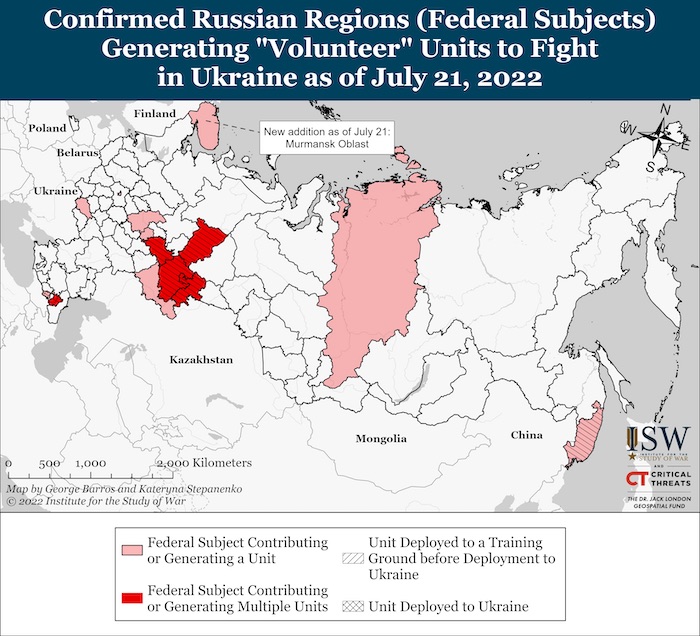
Russia ‘about to run out of steam after ‘epic fails’ in Ukraine, MI6 chief says, Sky News reports. “The MI6 spy chief said Russia had suffered “epic fails” in its initial objectives, which he listed as toppling the Ukrainian government, capturing Kyiv, and sowing division within the NATO alliance.
Russia’s focus has shrunk to the east of Ukraine, where it is waging a bloody war of attrition. Mr Moore said: I think they are about to run out of steam. I think our assessment is that the Russians will increasingly find it difficult to find manpower, and material, over the next few weeks, they will have to pause in some way and that will give the Ukrainians opportunities to strike back.
Their morale is still high, they are starting to receive increasing amounts of good weaponry. It is important for the Ukrainians themselves that they demonstrate their ability to strike back. That will be important for their continuing high morale.
Mr Moore said it was a significant reminder for the rest of Europe that “this is a winnable campaign by the Ukrainians”, as allies brace for what will be a “pretty tough winter” while the impact of Europe trying to wean itself off a dependence on Russian energy is felt. Offering a quote from the TV series Game Of Thrones, Mr Moore said: Winter is coming and clearly in that atmosphere, with the pressure on gas supplies, we are in for a tough time.”
Russia is not able to realize its ambitions in Ukraine, the Canadian Armed Forces reports. “Russia has claimed that, in response to Western military aid being provided to Ukraine, it has been “forced” to expand its goals beyond the “liberation” of the Donbas region of eastern Ukraine to include other major portions of the country. The facts say:
- Russia has always had maximalist geographic ambitions in Ukraine. Moscow’s failed efforts to capture Kyiv and the northeastern cities of Chernihiv, Sumy, and Kharkiv at the outset of the invasion demonstrate these significant territorial ambitions far beyond the Donbas.
- Russian forces have also occupied parts of southern Ukraine since February, which precedes the delivery of recent Western aid to Ukraine that Moscow is using as a pretext for expanding military objectives.
- Due to considerable losses of personnel and equipment, Russia likely no longer has the military capability to achieve its ambitions in Ukraine.
- It is now being forced to scale down its strategic objectives while providing a new public rationale for the piecemeal territorial control it has achieved.
Russia’s losses in the war are significant, but not yet critical – Ukrainian Intelligence, Ukrainska Pravda reports, citing Vadym Skibitskyi, representative of the Defence Intelligence of Ukraine (DIU). “The losses sustained by the Russian armed forces in the war are significant but not yet critical because they have a large potential source of mobilisation, but the problems in the occupier’s troops remain.
According to Skibitskyi, it is chiefly the staffing of combat units, which lack specialities such as mechanics/drivers and gunners, that require special training. The Chief Intelligence Directorate also reports that the invaders’ permanent areas deployment does not have enough personnel to form a battalion or a battalion tactical group. Therefore, these are now being formed from different areas.
According to Ukrainian Intelligence, Russia conducts covert mobilisation in three different ways. [Firstly], mobilisation in Russia takes place covertly. The country’s Combat Army Reserve is now being used to equip rifle battalions. We have clear evidence of this. There are no medical screenings or other procedures – you just sign a contract at the Military Commissariat and go to the front.
The second method of mobilisation in the Russian Federation is the formation of volunteer battalions on a nationwide basis. The Kremlin has given instructions to create such battalions in all federal entities. The number of troops in one battalion is 500-600 people who will fight in Ukraine.
The use of mercenaries is also widespread. They are mostly natives of Middle Eastern countries, a practice that also goes against international conventions. Currently, Russia has not announced mobilisation, because to do so would require a declaration of war. For the Kremlin, doing so would mean declaring defeat and a failure to implement previously announced plans.”
Ukraine has discovered previously unknown Russian hacking techniques, the US Cyber Command says, The New York Times reports. “Ukraine has continued to block Russian efforts to penetrate its computer networks since Moscow invaded the country in February and has been sharing information with American authorities about previously unknown hacking techniques, the US Cyber Command said Wednesday.
The new techniques had been discovered over the past few months, and on Wednesday the United States and Ukraine jointly made public 20 new indicators of possible Russian intrusion into computer networks that use previously unknown forms of malware, the command said. Ukraine has demonstrated a remarkable ability to hunt down and block Russian attacks on its networks, American and allied officials say. While the US government and tech companies have helped stop some of those attacks, officials say that Ukrainian network defenders, trained by Britain and the United States, deserve much of the credit.
The joint release of information served as a demonstration of the continued cooperation between the US officials and Ukraine’s domestic intelligence agency […]. By making the new forms of Russian malware public, the US Cyber Command said, it hopes that American companies will be able to bolster their defenses against potential cyberattacks.
“These indicators of compromise were shared with us by our Ukrainian partners to enable the industry to take action and assess their own networks,” said Maj. Katrina Cheesman, a spokeswoman for the Cyber National Mission Force, a wing of US Cyber Command devoted to thwarting hackers.
Since starting the war in February, Russia has stepped up efforts to use computer network intrusions to collect information around the world, according to Microsoft. Still, Moscow has largely held off from mounting major cyberattacks against critical infrastructure belonging to the United States and its allies. American officials say the threat of a Russian cyberattack remains serious, but so far Moscow appears to have been deterred from attacking the United States.”
Lukashenko reveals Belarus’s role in Russia’s war against Ukraine, Ukrainska Pravda reports, citing the Belarusian news agency BelTA. “Lukashenko claims that Belarus “is not fighting in the war in Ukraine with either hardware or manpower”. He admitted that strikes on Ukrainian military facilities have been launched from Belarusian territory, but this was supposedly done “for preventative purposes”.
“Why did they [the Ukrainians] deploy four divisions on the border? Why did they target us? Are you saying that I had to sit and wait until missiles began to fall on the heads of the Belarusian people? No, I did not.
I support Russia because it preempted you [NATO]. If the Russian military had missed this moment, Russia would have been forced to face a massive blow from NATO, not from Ukraine. It’s not Ukraine that is fighting right now, it’s you who are fighting: your soldiers and your weapons. You’re more of an aggressor than I am.”
2. Consequences and what to do?
Ukraine’s economy to contract by third in 2022 – NBU, Ukrinform reports. “Ukraine’s economy will shrink by a third in 2022, but if the Black Sea ports are unblocked, it will return to growth in 2023-2024, NBU Governor Kyrylo Shevchenko said.
He noted that Russia’s all-out offensive had led to a sharp decline in economic activity in Ukraine. At the beginning of the war, a third of the enterprises stopped their activities. The reasons for this are the physical destruction and temporary occupation of entire regions, a high level of uncertainty and risks, the disruption of logistical and production ties, and forced mass migration of the population. However, already in April, economic activity began to revive, with businesses and the population slowly adapting to the new operating conditions. This was also facilitated by the liberation of the northern regions and a decrease in the number of regions where active hostilities are taking place.
“As a result, in the second quarter, according to the estimates of the National Bank, the decline of the economy was close to 40%,” Shevchenko said.
He noted that hostilities in the east and south, the destruction of infrastructure in other regions, the blockade of seaports and low demand in most sectors will restrain the recovery of the economy in the coming months. A significant contribution to the fall in GDP will be a decrease in activity in agriculture due to temporary occupation and mining of land, loss of equipment and grain elevators, as well as sometimes untimely and insufficient treatment of land with fertilizers and plant protection products. As a result, the economy will shrink by a third this year. A moderate strengthening of consumer demand, adjustment of technological and logistic processes and revitalization of investment activity, including thanks to the prospects of Ukraine’s European integration, is expected after the active phase of the war is over.”
Inflation in Ukraine to exceed 30% this year, Ukrinform reports. “According to our forecast, the growth rate of consumer prices will exceed 30% at the end of 2022,” Shevchenko said.
He added that inflation in June rose sharply and reached 21.5% year-on-year mainly due to shocks caused by the war and due to global price pressures. The war led to the disruption of supply chains, a reduction in the supply of certain goods, an increase in business costs, the physical destruction of production facilities and infrastructure, as well as the temporary occupation of certain territories. The persistence of high energy prices and record levels of inflation in partner countries also significantly increased price pressure in Ukraine.
Taking into account the consequences of the war and the significant contribution from the increase in administrative prices, the National Bank expects inflation to decrease to 20.7% in 2023 and to 9.4% in 2024. Its return to the 5% target is expected in 2025, Shevchenko said.”.
Hans Petter Midttun:
The British and Canadian assessments that Russia is ‘about to run out of steam and is not able to realize its ambitions in Ukraine is in line with previous appraisals by the head of the Defence Intelligence of Ukraine. From a purely military perspective, they make sense.
Russian failure to capture Kyiv, Chernihiv, Sumy and Kharkiv, massive losses of manpower and equipment, and their subsequent withdrawal from the northern axis in an attempt to refocus its military efforts in the east, were a prelude to what followed. For the last months, its speed of advance has become increasingly slower. With the introduction of the HIMARS and western artillery on the battlefield, the advance seems to be slowly grinding to a halt as Russian ammunition depots and command posts are being targeted by long-range fire.
The Russian Army is also suffering from a logistical collapse of their own doing. The poor quality of steel used in its main battle tanks and armoured vehicles, the lack of proper maintenance and spare parts, combined with design flaws and logistical failure to sustain operations, might indicate that Putin’s army is facing the prospect of a long walk home on foot. The morale and spirit of the Russian soldiers are, understandingly, at a low.
But all of this – the sense that Russia is failing and the tide is turning – is based on the assumption that the Russian Army needs to advance to be victorious. I don’t believe that to be the case. It only needs to defend and hold what it has already occupied.
This isn’t a conventional war. It is a Hybrid War in which the military element is only one out of several tools being employed to undermine Ukrainian statehood. Military power is, however, an essential element and serves three purposes.
Firstly, it supports and reinforces the effect of non-military means. The maritime blockade is an example of this. It is effectively stopping both Ukrainian imports and exports, effectively undermining the Ukrainian economy. The war itself has helped reduce its GDP by a third, triggering high inflation, inflation and extreme defence expenditure.
In the report “Ukrainian storm warning”, I stressed that “any interruption of maritime trade and freedom of navigation will cause ripple effects across all sectors of the Ukrainian economy and society, as its future prosperity is closely linked to the maritime domain.” A Russian blockade of all Ukrainian ports will cause the Ukrainian economy to collapse.
Secondly, the employment of military power combined with influence operations effectively stops Western direct intervention in Ukraine. This allows it to uphold its military efforts, refocusing on holding occupied territories, illegally integrating them into the Russian Federation and, crucially, preparing for the next military offensive sometime in the future.
Crucially, it also helps undermine NATO, as well as the transatlantic and European unity as a part of its broader strategic aim. The Alliance has been deterred by Russia and has stepped away from its past commitment to stop conflicts threatening to impact the security of its member states and has decided to provide Ukraine with nonlethal support only. Lethal military equipment is being delivered by Ukraine’s international partners. Being exposed to the ripple effects of war in Ukraine and facing a potential recession if Russia decides to expand its economic warfare by cutting gas supplies to Europe, the EU is also showing signs of discord.
Thirdly, it has enabled Russia to occupy new territory to bit-by-bit reduce Ukraine and expand its ability to impose its will on its neighbour. What started with the Crimean Peninsula in 2014 has expanded to also include most of Luhansk, Donetsk, Zaporizhzhia and Kherson in 2022. Equally important, it has turned the Sea of Azov and the Black Sea into a “Russian lake” after having established jurisdiction over the Ukrainian Exclusive Maritime Zones.
The key message is that a 3-dimensional problem needs a 3-dimensional solution.
The single-minded focus on the military situation – further limited to ground operations in the East only – will render us unable to come up with an effective counter-strategy. Western support to Ukraine allows it to counter the Russian Army but renders it unable to operate in the Air and at Sea. The support is not designed to counter the Hybrid War, which after more than 8 years continues to undermine the basis for Ukrainian statehood.






